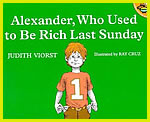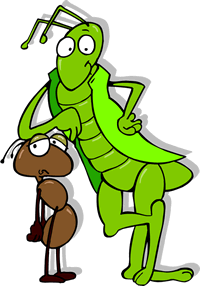Fourth Grade - Language Arts
Activities
ABCs of Saving
Financial and Economic Concepts: Savings and Financial Investments Fourth Grade – Language Arts
Fourth Grade – Language Arts
Key Ideas and Details: Reading: Literature Standard 2: Determine a theme of a story, drama, or poem from details in the text; summarize the text.
Key Ideas and Details: Reading: Literature Standard 9: Compare and contrast the treatment of similar themes and topics (e.g., opposition of good and evil) and patterns of events (e.g., the quest) in stories, myths, and traditional literature from different cultures.
Craft and Structure: Reading: Literature Standard 4: Determine the meaning of words and phrases as they are used in a text, including those that allude to significant characters found in mythology (e.g., Herculean).
Time: 45 Minutes
Materials: Computer with Internet, projector, writing materials
Writing a Math Story
Financial and Economic Concepts: Scarcity and Choices, Goods & Services Fourth Grade – Language Arts
Fourth Grade – Language Arts
Text Types and Purposes: Writing Standard 3: Write narratives to develop real or imagined experiences or events using effective technique, descriptive details, and clear event sequences.
 Lesson Time: 40 minutes
Lesson Time: 40 minutes
Supplies: paper and pencil, Alexander, Who Used to be Rich Last Sunday.
After learning how to add and subtract decimals, the students will listen to Alexander Who Used to be Rich Last Sunday by Judith Viorst, then write their own story that involves adding and subtracting money. Students are required to show their math work.
- The students will listen as I read Alexander Who Used to be Rich Last Sunday.
- Class will discuss the steps that happened in the story to cause Alexander to not be rich anymore.
- The students will write their own story either about themselves or a made up character that involves the addition and subtraction of money.
- Instructor will give them an example: I started with $200 that I got for my birthday. I wanted to buy this really cool CD so I did. It cost $15.95. That left me with $184.05. I had to babysit for my neighbor on Tuesday and I made $12. Now I have $196.05.
- When students are finished they must turn in their story and show their math work for each step of the problem.
The students will be assessed on the accuracy of the math work in the story.
![]() Writing a Math Story – Language Arts Rubric (pdf)
Writing a Math Story – Language Arts Rubric (pdf)
Business Brainstorm
Financial and Economic Concepts: Entrepreneurism Fourth Grade – Language Arts
Fourth Grade – Language Arts
Presentation of Knowledge and Ideas: Speaking and Listening Standard 4: Report on a topic or text, tell a story, or recount an experience in an organized manner, using appropriate facts and relevant, descriptive details to support main ideas or themes; speak clearly at an understandable pace.
Presentation of Knowledge and Ideas: Speaking and Listening Standard 5: Add audio recordings and visual displays to presentations when appropriate to enhance the development of main ideas or themes.
 Time: 20 Minutes
Time: 20 Minutes
Materials: Option between computer with internet/projector or handouts
This visual can be projected via an LCD projector during class. Teachers may also use the presentation to guide a classroom discussion. Use it to help students brainstorm what types of jobs would be suitable for them to pursue. Printed format at left with content only.
![]() Twenty Money-Making Ideas (pdf)
Twenty Money-Making Ideas (pdf)
After viewing the visual or discussing the printout discuss words that students did not know or understand. Have them suggest the meaning of the new words before you tell them. Have them use the surrounding words to figure out the meaning of the new words. Then have students come up with at least five ideas of ways they can make money that have not been mentioned.
The Ant and the Grasshopper
Financial and Economic Concepts: Scarcity and Choices Fourth Grade – Language Arts
Fourth Grade – Language Arts
Key Ideas and Details: Reading: Literature Standard 2: Determine a theme of a story, drama, or poem from details in the text; summarize the text.
Craft and Structure: Reading: Literature Standard 4: Determine the meaning of words and phrases as they are used in a text, including those that allude to significant characters found in mythology (e.g., Herculean).
 Time: 20-40 Minutes
Time: 20-40 Minutes
Materials: Handouts, audio player
- Pass out a copy of "The Ant and the Grasshopper" for each student.
 The Ant and the Grasshopper (pdf)
The Ant and the Grasshopper (pdf)
- Have them read the fable once, circling five words they do not know.
- Listen to "The Ant and the Grasshopper"
 The And and the Grasshopper (MP3 download)
The And and the Grasshopper (MP3 download)
- Have students figure out the meaning of the five words they circled by using the context around those words.
- In pairs, have students explain their words to their partner.
The following questions about "The Ant and the Grasshopper" should also be discussed and reflected upon with your students.
- What were the ants saving for? [Food for the winter]
- What did the ants give up? [Time playing or relaxing]
- What was the grasshopper's opportunity cost? [Food for winter]
- What have you had to give up to get something else? [answers will vary]
Opportunity cost: The second-best alternative (or the value of that alternative) that must be given up when scarce resources are used for one purpose instead of another.
Entrepreneur Ad
Financial and Economic Concepts: Entrepreneurism Fourth Grade – Language Arts
Fourth Grade – Language Arts
Production and Distribution of Writing: Writing Standard 4: Produce clear and coherent writing in which the development and organization are appropriate to task, purpose, and audience. (Grade-specific expectations for writing types are defined in standards 1–3 above.)
Production and Distribution of Writing: Writing Standard 6: With some guidance and support from adults, use technology, including the Internet, to produce and publish writing as well as to interact and collaborate with others; demonstrate sufficient command of keyboarding skills to type a minimum of one page in a single sitting.
Comprehension and Collaboration: Speaking and Listening Standard 1: Engage effectively in a range of collaborative discussions (one-on-one, in groups, and teacher-led) with diverse partners on grade 4 topics and texts, building on others’ ideas and expressing their own clearly.
 Time: 30 Minutes
Time: 30 Minutes
Materials: Writing materials, art supplies
Have the students choose one money-making idea and create a flier that advertises what they are selling. Emphasize the elements that they will want to include in their flier.
Evaluate using the rubric below.
![]() Complete Lesson Plan (See Activity 2)
Complete Lesson Plan (See Activity 2)
![]() Entrepreneur Ad Rubric (pdf)
Entrepreneur Ad Rubric (pdf)
Making Choices
Financial and Economic Concepts: Scarcity & Choices Fourth Grade – Language Arts
Fourth Grade – Language Arts
Production and Distribution of Writing: Writing Standard 4: Produce clear and coherent writing in which the development and organization are appropriate to task, purpose, and audience.
Production and Distribution of Writing: Writing Standard 10: Write routinely over extended time frames (time for research, reflection, and revision) and shorter time frames (a single sitting or a day or two) for a range of discipline-specific tasks, purposes, and audiences.
 Time: 30 Minutes
Time: 30 Minutes
Materials: Writing materials
This lesson teaches students the answers to questions such as: What does the word choice mean? Why do we have to make choices when we decide how to spend money? What are some things that kids spend money on?
Have students bring in and discuss examples from books, magazines, and movies where people deal with budgets and make decisions about how to spend money. What decisions were made, and why?
Everyone has to make decisions when it comes to spending money. Directions for Writing: Think about a time when you had to decide how to spend money. Now explain why you made the choice that you did.
![]() Student Magazine Pages and Worksheets: Time to Choose! (pdf)
Student Magazine Pages and Worksheets: Time to Choose! (pdf)


